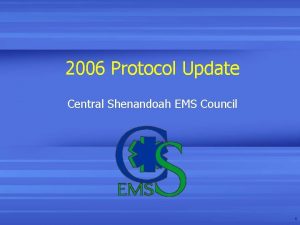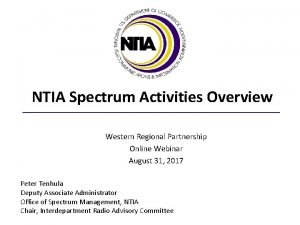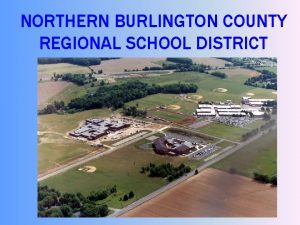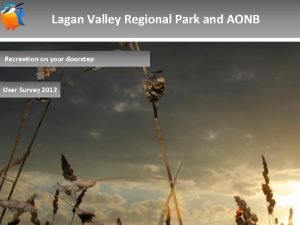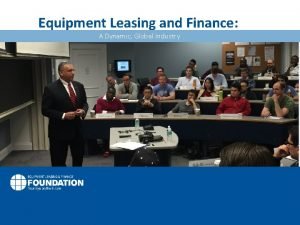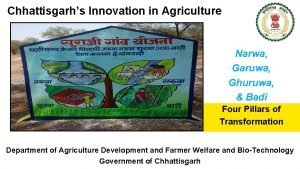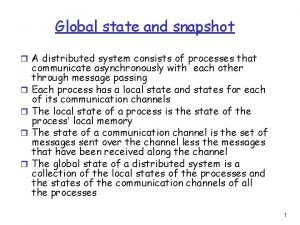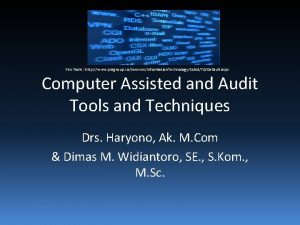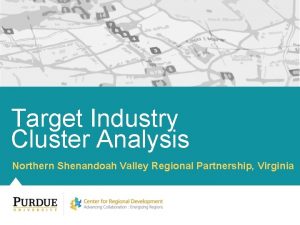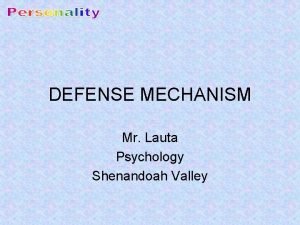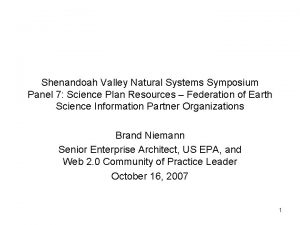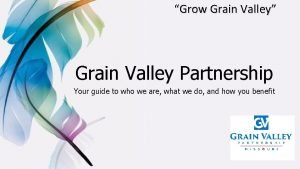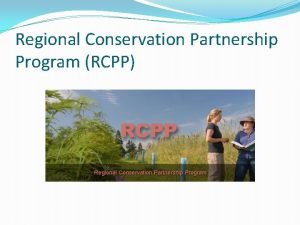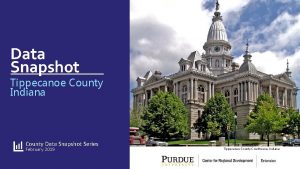REGIONAL SNAPSHOT Northern Shenandoah Valley Regional Partnership NSVRP
































- Slides: 32

REGIONAL SNAPSHOT Northern Shenandoah Valley Regional Partnership (NSVRP), Virginia

Table of contents 01 02 03 Overview Demography Human capital 04 05 Labor force Industry and occupation

01 overview Northern Shenandoah Valley Regional Partnership (NSVRP), VA What is a regional snapshot?

Overview Northern Shenandoah Valley Regional Partnership, VA Northern Shenandoah Valley Regional Partnership (NSVRP) Region is comprised of six Virginia counties. I-81 crosses the region from south to north and connects to I-70 to the north. I-66 connects the region to Washington, DC. § § § Clarke Frederick Page Shenandoah Warren Winchester section 01 4

Overview What is a regional snapshot? What is the snapshot? This snapshot is a demographic and economic assessment of the Northern Shenandoah Valley Regional Partnership (NSVRP) Region in Virginia. Using countylevel data, PCRD analyzed a number of indicators to gauge the overall economic performance of the NSVRP Region in comparison to the rest of the state. What is its purpose? The snapshot is intended to inform the region’s leaders, organizations and residents of the key attributes of the region’s population and economy. In particular, it takes stock of the region’s important assets and challenges. With such data in hand, regional leaders and organizations are in a better position to invest in the mix of strategies that will spur the growth of the economy and provide a higher quality of life for residents of the region. What are its focus areas? PCRD secured analyzed recent data from both public and private sources to generate the snapshot. In order to build a more comprehensive picture of the region, the report presents information under four key categories. § § Demography Human Capital Labor Force Industry & Occupation When appropriate or relevant, the report compares information on the region with data on the remainder of the state. By so doing, the region is better able to determine how well it is performing relative to the state on a variety of important metrics. section 01 5

02 demograph y Population change Age structure Income and poverty

Demography Population change Total population projections 12. 8% NSVRP, VA 7, 778, 872 6, 893, 233 Rest of Virginia 185, 28 2 2000 19. 9% 222, 15 2 2000 -2010 5. 7% 4. 1% 8, 096, 090 3. 6% 230, 19 9 8, 558, 648 9. 8% 252, 86 4 2010 -2014 -2020 Questions: • How does the region’s population trend compare to that of the state? • What may be some of the elements driving the trends in the region? In the state? • What strengths or challenges might these trends present? section 02 Source: 2000 & 2010 Census, 2014 Population Estimates, and 2020 Population Projection by Demographics Research Group, Weldon Cooper Center for Public Service, University of Virginia, http: //www. coopercenter. org/demographics/virginia-populationprojections 7

Demography Race 2000 Ethnicity Hispanics - 2000 Black 3, 9% Asian 0, 6% Other 7, 0% American Indian & Alaska Native 0, 2% Native Hawaiian & Other Pacific islander 0, 02% White 93, 0% Two or More Races 2, 3% Hispanics 2014 - 2014 7. 1 % section 02 Data Source: U. S. Census Bureau – 2000 Decennial Census and 2014 Annual Population Estimates 8

Demography Population Age Structure, 2000 A visual presentation of the age distribution of the population (in percent) section 02 Source: 2000 Decennial Census, U. S. Census Bureau 9

Demography Population Age Structure, 2014 A visual presentation of the age distribution of the population (in percent) Questions: • Is the region experiencing an aging of its population? How does this compare to the rest of the state? • Is there a sizable number of people of prime working age (20 -49 years of age) in the region? • Is the youth population (under 20 years old) growing or declining? • What are the implications of the region’s age structure for the economic development efforts of the region? section 02 Source: 2014 Population Estimates, U. S. Census Bureau 10

Demography Income and poverty Questions: 2003 Total Population in Poverty Minors (Age 0 -17) in Poverty Real Median Household Income* ($ 2013) 2008 2013 8. 9% 9. 7% 10. 8% 12. 4% 13. 3% 16. 1% $57, 849 $58, 329 $57, 042 • Is the poverty rate for individuals in the county getting better or worse? • Is poverty for minors in the county lower or higher than the overall poverty rate for all individuals? Why? • Has real median income (adjusted for inflation) improved or worsened over the 2003 to 2013 time period? What may be reasons for these changes? section 02 * Note: Regional Median Household income is the population-weighted average of median household income values across the NSVRP Region counties. Source: U. S. Census Bureau – Small Area Income and Poverty Estimates (SAIPE) 11

03 human capital Educational attainment Patents

Human capital Educational attainment, 2013 NSVRP Region 9% Rest of Virginia 6% 15% 5% 21% 7% 20% 34% • What proportion of the adult population in the region has only a high school education? • How many are college graduates (bachelors degree or higher)? • How does the educational profile of the region compare to that of the rest of the state? • What are the implications of the educational profile of the region in terms of the region’s economic opportunities or workforce challenges? 7% 10% 14% Questions: 25% 7% 20% No high school Associate’s degree Some high school Bachelor’s degree Graduate degree High school diploma Some college section 03 Source: 2009 -2013 American Community Survey 5 -Year Estimates 13

Human capital Patents per 10, 000 Jobs 2001 -2013 From 2001 to 2013, NSVRP Region counties were issued patents at a rate of 1. 40 per 10, 000 jobs, while the remaining Virginia counties garnered 2. 71 patents per 10, 000 jobs. Patenting trends are an important indicator of the level of innovation in a region. Commercializing this innovation can lead to longterm growth for regional economies. Questions: Patents per 10, 000 residents • How does the region’s patent rate compare to that of the rest of the state? • How have rates changed over time? • What might this data suggest for the future of the region? 2001 -2013 From 2001 to 2013, 0. 86 patents per 10, 000 residents were issued in NSVRP Region counties. The rest of Virginia amassed 1. 65 patents per 10, 000 residents. section 03 Source: U. S. Patent and Trademark Office, Census, BEA *Note: Patent origin is determined by the residence of the first-named inventor. Since a number of workers commute into the region, the number of patents produced in the NSVRP Region could be high. However, among residents of the region, patent production is relatively 14 low.

04 labor force Unemployment rates Earnings per worker Source of labor for the region

Labor force Unemployment rates 10, 0% Questions: 9, 6% 9, 0% 8, 2% 8, 0% 7, 1% US Total 6, 2 % 6, 0% 4, 0% 3, 8% 3, 5% 3, 0% • How does the region’s unemployment peak and post-2009 recovery compare to the state and nation? • What might this suggest for the region’s economic future? 5, 2% 5, 5% 4, 6% How does the region’s unemployment rate compare to the rest of the state and nation? NSVRP Region 7, 0% 5, 0% • Rest of Virginia 3, 0% 2004 2005 2006 2007 2008 2009 2010 2011 2012 2013 2014 Source: LAUS, BLS section 04 16

Labor force Earnings per worker in 2014 Questions: • • • How does the region’s average earnings compare to that of the rest of the state? What might be some driving factors for the differences? Do these represent potential strengths or challenges for the region? NOTE: Earnings include wages, salaries, supplements and earnings from partnerships and proprietorships NSVRP Region $60 000 $55 677 Rest of State $45 000 $41 748 $30 000 $15 000 $0 Average earnings section 04 Source: EMSI Class of Worker 2014. 4 (QCEW, non-QCEW, self-employed and extended proprietors) 17

Labor force Journey to Work 55, 300 28, 728 Population 2013 Jobs Employed in Region 84, 028 100. 0% Employed in Region but Living Outside 28, 728 34. 2% Employed and Living in Region 55, 300 65. 8% Questions: • • Out-Commuters Same Work/ Home In-Commuters Proportion 49, 569 2013 Jobs Population Region Residents Proportio n 104, 869 100. 0% Employed Outside Region but Living in Region 49, 569 47. 3% Employed and Living in Region 55, 300 52. 7% How many people employed in the region actually reside outside the region? How many who live in the region commute to jobs outside the region? What are the implications for the region’s economic development efforts? section 04 Source: LEHD, OTM, U. S. Census Bureau 18

05 industry and occupation Establishments Employment by industry Cluster analysis Top occupations STEM occupations

Industry and occupation Establishments Components of Change for Establishments 2000 -2011 Establishments Launched Establishments Closed Net Change An establishment is a physical business location. 19, 583 9, 562 10, 021 Net Migration (Establishments moving into minus Establishments moving out of the region) Total Change Percent Change 451 10, 472 113. 4% Branches, standalones and headquarters are all considered types of establishments. Definition of Company Stages Self 2 -9 0 2 employed 10 -99 employees 4 1 3 employees 100 -499 employees 500+ employees section 05 Source: National Establishment Time Series (NETS) – 2011 Database 20

Industry and occupation Establishments Number of Establishments by Company Stages 2000 Stage Establishments 2011 Proportion Establishments Proportion Stage 0 2, 522 27. 3% 5, 178 26. 3% Stage 1 5, 144 55. 7% 12, 710 64. 5% Stage 2 1, 415 15. 3% 1, 661 8. 4% Stage 3 132 1. 4% 144 0. 7% Stage 4 21 0. 2% 13 0. 1% 9, 234 100% 19, 706 100. 00% Total Questions: • What stage businesses have shaped the region’s economic growth in the last 10 years? • Which ones are growing or declining the most? • Which stage of establishments are likely to shape the region’s future economic growth? section 05 Source: National Establishment Time Series (NETS) – 2011 Database 21

Industry and occupation Establishments Number of Jobs by Company Stages % Change Year 2000 2011 Stage 0 Stage 1 Stage 2 Stage 3 Stage 4 2, 522 18, 879 34, 818 24, 060 25, 319 5, 178 36, 438 41, 970 25, 551 12, 679 105. 3% 93. 0% 20. 5% 6. 2% -49. 9% 105, 598 121, 816 15. 4% Total Questions • What establishments are the most numerous based on company stages? • What stages have experienced the largest growth? The greatest decline? • What company stage employs the largest number of people? • What stage captures the most sales? • Which ones have experienced the greatest percentage loss over the 2000 -11 period? Sales ($ 2012) by Company Stages Year 2000 2011 % Change Stage 0 $302, 852, 795 $367, 072, 470 21. 2% Stage 1 $2, 372, 885, 958 $2, 817, 471, 789 18. 7% Stage 2 $4, 178, 101, 148 $3, 558, 644, 578 -14. 8% Stage 3 $2, 991, 661, 550 $3, 252, 485, 564 8. 7% Stage 4 $2, 596, 003, 663 $1, 241, 081, 727 -52. 2% $12, 441, 505, 114 $11, 236, 756, 128 -9. 7% Total section 05 Source: National Establishment Time Series (NETS) – 2011 Database 22

Industry and occupation Top ten industry sector employment growth NAIC S 2009 Jobs Description 2014 Jobs Change (%) State Change (%) 52 Finance and Insurance 3, 689 4, 583 894 24% 14% 53 Real Estate and Rental and Leasing 5, 052 6, 051 999 20% 15% 56 Administrative and Support and Waste Management and Remediation Services 5, 075 5, 925 850 17% 9% 61 Educational Services 3, 038 3, 544 506 17% 13% 71 Arts, Entertainment, and Recreation 2, 255 2, 630 375 17% 13% 22 Utilities 240 278 38 16% -7% 62 Health Care and Social Assistance 11, 980 13, 430 1450 12% 11% 55 Management of Companies and Enterprises 912 1, 017 105 12% 2% 54 Professional, Scientific, and Technical Services 4, 536 5, 027 491 11% 2% 48 Transportation and Warehousing 4, 108 4, 461 Questions: • What regional industry sectors have seen the greatest growth? • Did they grow at the same rate as the state? • What factors are causing the growth? 353 9% 5% section 05 Source: EMSI Class of Worker 2014. 4 (QCEW, non-QCEW, self-employed and extended proprietors) 23

Industry and occupation Top six industry sector employment decline Change (%) State Change (%) 12, 438 -837 -6% -2% 2, 448 2, 349 -99 -4% -1% Construction 7, 894 7, 590 -304 -4% -7% 51 Information 1, 233 1, 196 -37 -3% -10% 21 Mining, Quarrying, and Oil and Gas Extraction 238 234 -4 -2% -4% 11 Crop and Animal Production 3, 543 3, 497 -46 -1% -2% NAIC S Description 2009 Jobs 2014 Jobs 31 Manufacturing 13, 275 42 Wholesale Trade 23 Questions: • How does the industry sector make-up of the region compare to the rest of the state? • Which industry sectors are growing and declining the most in employment? section 05 Source: EMSI Class of Worker 2014. 4 (QCEW, non-QCEW, self-employed and extended proprietors) 24

Industry cluster analysis How to interpret cluster data results The graph’s four quadrants tell a different story for each cluster. Contains clusters that are more concentrated in the region but are declining (negative growth). These clusters typically fall into the lower quadrant as job losses cause a decline in concentration. Mature Top left (strong but declining) Transforming Contains clusters that are under-represented in the Bottom left region (low concentration) (weak and are also losing jobs. Clusters in this region may declining) indicate a gap in the workforce pipeline if local industries anticipate a future need. In general, clusters in this quadrant show a lack of competitiveness. Contains clusters that are more concentrated in the region and are growing. These clusters are strengths that help a region stand out from the competition. Small, high-growth clusters Top right can be expected to become more dominant over time. (strong and Stars advancing) Emergin g often Bottom right (weak but advancing) Contains clusters that are under-represented in the region but are growing, quickly. If growth trends continue, these clusters will eventually move into the top right quadrant. Clusters in this quadrant are considered emerging strengths for the region. section 05 Modified from: http: //www. charlestonregionaldata. com/bubble-chart-explanation / 25

Industry and occupation Distribution of clusters in the Region by quadrants section 05

Industry cluster analysis Mature Clusters Forest & Wood Products (1. 93; 3, 190) Transportation & Logistics (1. 22; 4, 438) Printing & Publishing (1. 15; 2, 280) Advanced Materials (1. 09; 3, 748) Arts, Ent, Rec. & Visitor Industries (1. 00; 4, 734) Primary Metal Manufacturing (1. 00; 263) Level of Specialization Chemicals & Chemical Based Prod (2. 96; 4, 142) Star Clusters Agribusiness, Food Processing & Tech (2. 00; 6, 836) Percent Growth in Specialization Transforming Clusters Mining (0. 95; 324) Biomed/Biotechnical (Life Science) (0. 94; 8, 468) Fabricated Metal Product Mfg. (0. 92; 867) Energy(Fossil & Renewable) (0. 86; 5, 367) Elec Equip. , App & Component Mfg. (0. 58; 145) Manufacturing Supercluster (0. 48; 1, 891) Information Technology & Telecom. (0. 45; 2, 048) Machinery Manufacturing (0. 32; 246) Transportation Equipment Mfg. (0. 20; 206) Glass & Ceramics (0. 18; 36) Emerging Clusters Education & Knowledge Creation (0. 91; 2, 447) Apparel & Textiles (0. 68; 580) Business & Financial Services (0. 67; 10, 273) Defense & Security (0. 48; 2, 355) Computer & Electronic Product Mfg. (0. 24; 164) Note: Glass and ceramics cluster has too few jobs. section 02 NOTE: The first number after each cluster represents its location quotient while the second number represents the number of total jobs (full and part time jobs by place of work) in that cluster in the region in 2014. The clusters are sorted in decreasing order by location quotient. 27

Industry Clusters: Leakages Regional requirements, 2013 Note: ** shows Star clusters section 05 Source: EMSI 2014. 4 (QCEW Employees, Non-QCEW Employees, Self-Employed, and Extended Proprietors); Industry cluster definitions by PCRD 28

Industry and occupation Top five occupations in 2014 Transportation and Material Moving Occupations 7, 1% Questions: Management Occupations All Other 7, 2% Occupations Food Preparation 52, 1% and Serving Related Occupations Office and 7, 4% Administrative Support Occupations 11, 7% Sales and Related Occupations 14, 6% • What are the education and skill requirements for these occupations? • Do the emerging and star clusters align with the top occupations? • What type salaries do these occupations typically provide? section 05 Source: EMSI Class of Worker 2014. 4 (QCEW, non-QCEW, self-employed and extended proprietors) 29

Industry and occupation Science, Technology, Engineering & Math Job change in STEM occupations* NSVRP Rest of Virginia Questions: 214, 345 213, 850 2, 194 1, 999 200 9 201 4 10% 0. 2% Change • How do STEM jobs compare to the state? • What has been the trend of STEM jobs over time? • How important are STEM jobs to the region’s Star and Emerging clusters? *Note: STEM and STEM-related occupation definitions from BLS (2010) section 05 Source: EMSI Class of Worker 2014. 4 (QCEW, non-QCEW, self-employed and extended proprietors) 30

Report Contributors This report was prepared by the Purdue Center for Regional Development, in partnership with the Southern Rural Development Center and USDA Rural Development, in support of the Stronger Economies Together program. Report Authors Data Analysis Report Design Bo Beaulieu, Ph. D Indraneel Kumar, Ph. D Andrey Zhalnin, Ph. D Ayoung Kim Tyler Wright This report was supported, in part, by grant from the USDA Rural Development through the auspices of the Southern Rural Development Center. It was produced in support of the Stronger Economies Together (SET) program. 31

For more information, please contact: The Purdue Center for Regional Development (PCRD) seeks to pioneer new ideas and strategies that contribute to regional collaboration, innovation and prosperity. Dr. Bo Beaulieu, PCRD Director: ljb@purdue. edu Or 765 -494 -7273 November 2015
 Central shenandoah ems
Central shenandoah ems Northern ireland social work degree partnership
Northern ireland social work degree partnership Stour valley and poole partnership
Stour valley and poole partnership Western regional partnership
Western regional partnership Western regional air partnership
Western regional air partnership Niosh northern regional office (penang)
Niosh northern regional office (penang) Northern burlington county regional school district
Northern burlington county regional school district Lagan valley regional park
Lagan valley regional park Tree seeds
Tree seeds Valley mountain regional
Valley mountain regional Implied metaphor
Implied metaphor Operating lease
Operating lease Affirm and noaffirm in oracle data guard
Affirm and noaffirm in oracle data guard Snapshot
Snapshot Zoogov
Zoogov Equipment leasing and finance industry snapshot
Equipment leasing and finance industry snapshot Transport.tamu.edu
Transport.tamu.edu Snapshot reports in ssrs
Snapshot reports in ssrs Coherence and unity
Coherence and unity Safersys snapshot
Safersys snapshot Safersys company snapshot
Safersys company snapshot Snapshot study psychology
Snapshot study psychology Symbols used in logic
Symbols used in logic Financial peace snapshot
Financial peace snapshot Pamela schindler
Pamela schindler Company snapshot example
Company snapshot example Snapshot algorithms for fifo channels
Snapshot algorithms for fifo channels Safersys snapshot
Safersys snapshot Safersys
Safersys Snapshot
Snapshot Pragrup
Pragrup Snapshot essay
Snapshot essay Snapshot
Snapshot
